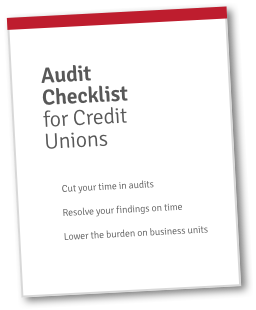Credit union auditors are often stretched thin. Many work in small teams with too many responsibilities and not enough time to complete them. The process of managing audits and examinations can be slow and cumbersome, requiring countless emails, spreadsheets, and status updates just to stay on track.
These inefficiencies add up, consuming valuable time and increasing risk.
The reality is that this job function isn’t typically well-staffed in credit unions. The lack of automation in audit management only makes things worse, leading to long workdays and added stress for audit staff.
Time Lost in Manual Processes
Many credit unions still rely on outdated methods to track audit requests, findings, and follow-ups. Emails and spreadsheets become the default tools, but they aren’t built for audit tracking.
There’s a lot of inefficiency. Manually sending emails, updating status spreadsheets, and requesting status reports burn a ton of time.
For auditors, this means more than just administrative headaches. Every hour spent tracking down documents or reminding departments to respond is an hour not spent on higher-level risk assessment. And when auditors are bogged down in administrative work, credit unions miss opportunities to strengthen internal controls and prepare for future risks.
Findings That Drag on for Months
Regulatory findings are unavoidable. Every credit union has them from time to time. But the problem isn’t getting findings—it’s managing them. Many credit unions struggle to track and resolve findings efficiently, leading to repeat issues and extended remediation timelines.
Unfortunately, unresolved and repeat findings can add up, slowing down the entire audit process, creating administrative “sludge.”
Often, credit unions get repeat findings, or outstanding ones that go unresolved for six or nine months. When findings sit unresolved for too long, they can lead to increased scrutiny from regulators, not to mention unnecessary financial and reputational risk.
Even credit unions that manage findings well often do so at a steep cost. And that cost is measured in time. Better performance in findings might require one or two people consistently working to follow up with their teams to address issues.
The time and effort required to track findings manually isn’t sustainable, especially for audit teams that are already spread thin.
The Bigger Risk for Growing Credit Unions
For credit unions focused on expansion, inefficiencies in audit management pose an even bigger risk. When teams are already overwhelmed, every new product, service, or market adds complexity. Without the ability to scale their audit function, credit unions risk creating gaps in oversight and compliance.
When your audit team is constrained for time, they can’t add anything new to their plate without also adding risk to the organization. Credit unions need a more efficient way to handle audits—not just to improve the process, but to keep up with growth without increasing risk.
Redboard is an audit management solution for credit unions. It automates a good deal of the administrative work, leading to a smoother audit process with fewer (and faster) findings.
Ready to see how much time you can save?


 Get FREE Access to the Audit Checklist for Credit Unions!
Get FREE Access to the Audit Checklist for Credit Unions!


